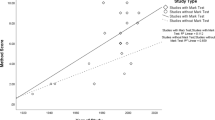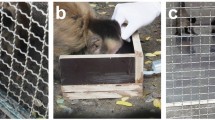Abstract
Mirror mediated object discrimination was investigated in a captive female, human-reared, western lowland gorilla (Gorilla gorilla gorilla) approximately 26 years of age. The gorilla was trained to find a stimulus that was only visible by use of the mirror. The gorilla could not reach the goal object except by observing it in the mirror and her hand movement was not visible through the mirror. Further, it was hypothesized that this mirror mediated object discrimination would enhance the probability of self-directed behavior.Gallup’s (1970) marking paradigm, excluding the use of general anesthesia, was utilized in assessing self-directed behavior. Mirror-gazing, face-directed, and mark-directed behavior with a mirror were compared before versus after discrimination mirror training. The results supported the hypotheses that gorillas are capable of mirror mediated object discrimination and that mirror training involving a discrimination task would facilitate self-directed behavior.
Similar content being viewed by others
References
Anderson, J. R., 1986. Mirror-mediated finding of hidden food by monkeys (Macaca tonkeana andMacaca fascicularis).J. Comp. Psychol., 100: 237–242.
Brown, W. L., A. A. McDowell, &E. M. Lobinson, 1965. Discrimination learning of mirrored cues by rhesus monkeys.J. Genet. Psychol., 106: 123–128.
Gallup, G. G., Jr., 1970. Chimpanzees: self-recognition.Science, 167: 86–87.
————,M. K. McClure, S. D. Hill, &R. A. Bundy, 1971. Capacity for self-recognition in differentially reared chimpanzees.Psychol. Rec., 21: 69–74.
————,L. B. Wallnau, &S. D. Suarez, 1980. Failure to find self-recognition in mother-infant and infant-infant rhesus monkey pairs.Amer. J. Primatol., 305: 541.
Itakura, S., 1987a. Mirror guided behavior in Japanese monkeys (Macaca fuscata).Primates, 28: 149–161.
————, 1987b. Use of mirror to direct their responses in monkeys (Macaca fuscata fuscata).Primates, 28: 343–352.
Ledbetter, D. &J. Basen, 1982. Failure to demonstrate self-recognition in gorillas.Amer. J. Primatol., 2: 307–310.
Menzel, E. W., Jr., E. S. Savage-Rumbaugh, &J. Lawson, 1985. Chimpanzees (Pan troglodytes) spatial problem solving with the use of mirrors and televised equivalents of mirrors.J. Comp. Psychol., 99: 211–217.
Patterson, F. G., 1978. Conversations with a gorilla.Nat. Geograph., 154: 438–465.
———— &R. H. Cohen, 1994. Self-recognition and self awareness in lowland gorillas. In:Self-awareness in Animals and Humans: Developmental Perspectives,S. Parker,R. W. Mitchell, &M. I. Boccia (eds.), Cambridge Univ. Press, Cambridge, pp. 273–290.
Suarez, S. D. &G. G. Gallup, Jr., 1981. Self-recognition in chimpanzees and orangutans, but not gorillas.J. Human Evol., 10: 175–188.
———— & ————, 1986. Social responding to mirrors in rhesus macaques: effects of changing mirror location.Amer. J. Primatol., 11: 239–244.
Author information
Authors and Affiliations
About this article
Cite this article
Nicholson, I.S., Gould, J.E. Mirror mediated object discrimination and self-directed behavior in a female gorilla. Primates 36, 515–521 (1995). https://doi.org/10.1007/BF02382873
Received:
Accepted:
Issue Date:
DOI: https://doi.org/10.1007/BF02382873




